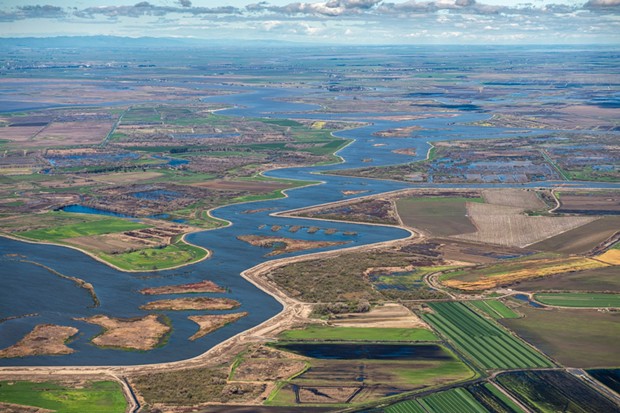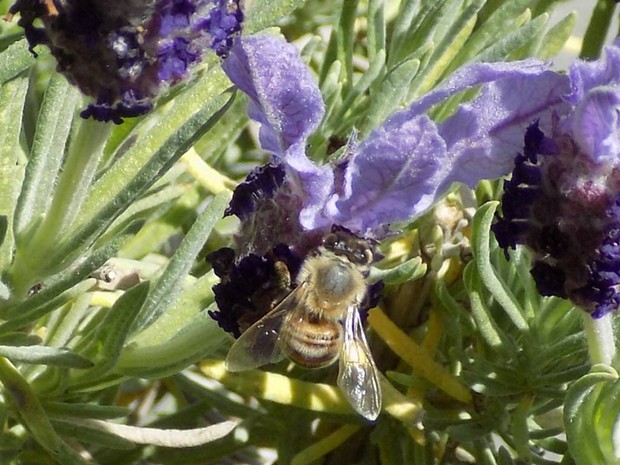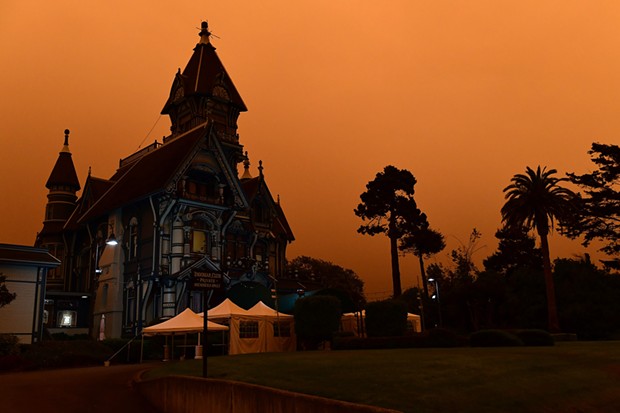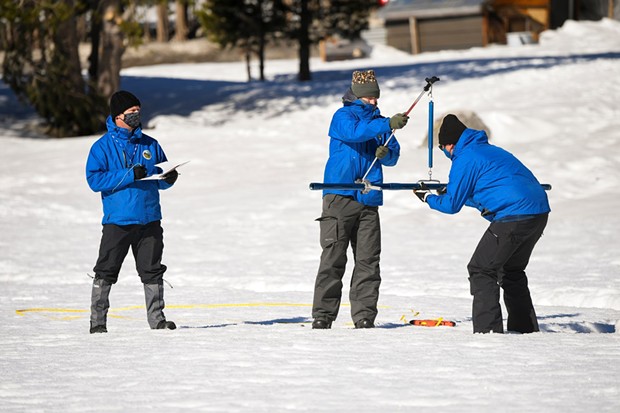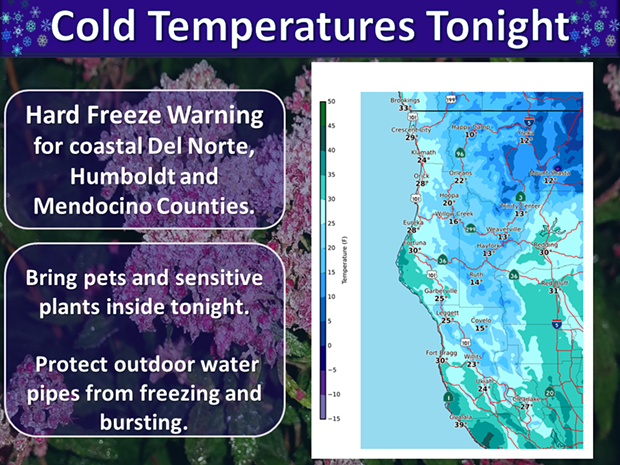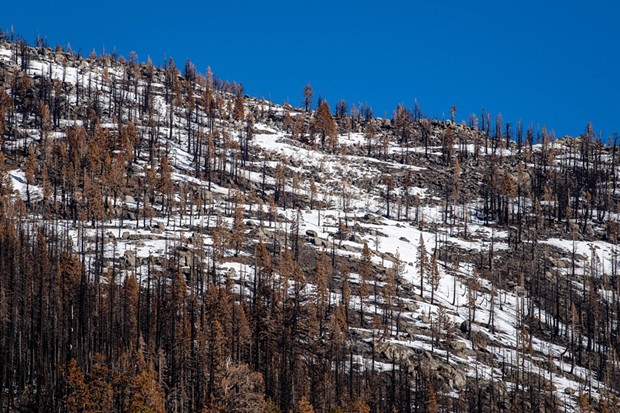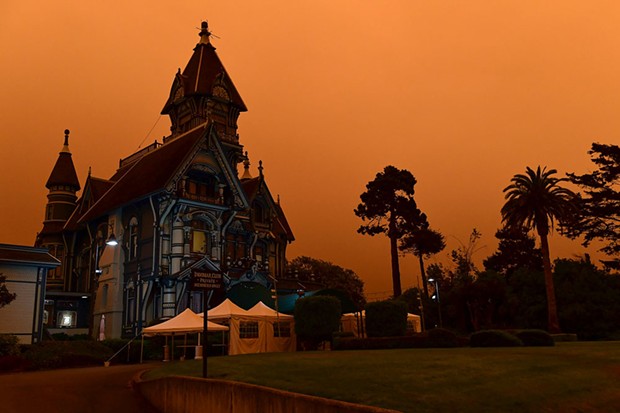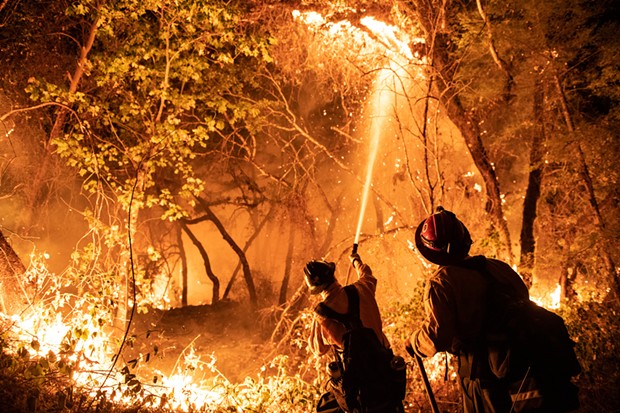Agriculture
Wednesday, July 27, 2022
Delta Tunnel: Salmon at Risk from Massive Water Project, State Report Says
Posted By Rachel Becker/CalMatters on Wed, Jul 27, 2022 at 11:24 AM
In the report, state officials said the tunnel project could harm endangered and threatened species, including the Delta smelt, winter-run chinook salmon and steelhead trout. To offset the “potentially significant impacts” on the rare fish, the Department of Water Resources says thousands of acres of other wetlands would have to be restored — which critics say is a slow and inefficient way to provide new habitat.
The draft environmental impact report is a major step in planning a tunnel that would fundamentally reshape California’s massive water management system.
The report outlines the proposed path of a 45-mile tunnel that would pipe water from the Sacramento River, bypassing the Delta, and funnel it into Bethany Reservoir, the “first stop” on a state aqueduct that funnels water south.
The goal of the project, which has been planned in various forms since the 1960s, is to shore up water supplies against environmental catastrophes such as earthquakes and the weather whiplash and sea level rise of climate change, according to California Natural Resources Secretary Wade Crowfoot.
Water agencies that can eventually sign on to receive the tunnel project’s water stretch from the Bay Area and Central Coast to the Central Valley and Southern California.
“It is a conundrum to be able to manage the Delta in a way that protects the environment, respects the communities that live there, and provides for the water supplies of a large portion of the state,” Crowfoot said.
Wednesday, July 20, 2022
California Poised to Restrict Bee-killing Pesticides
Posted By Rachel Becker/CalMatters on Wed, Jul 20, 2022 at 11:20 AM
The new limits would be among the nation’s most extensive for agricultural use of neonicotinoids, a class of insecticides used to kill plant-damaging pests like aphids. The highly potent pesticides have been shown to harm bees, birds and other creatures.
Aimed at protecting bees that pollinate crops, the California Department of Pesticide Regulation’s proposed rules would restrict four closely-related neonicotinoid chemicals: imidacloprid, thiamethoxam, clothianidin and dinotefuran.
Unveiled in February, the rules would limit when and how much can be applied, depending on the specific chemical, the crop and, in some cases, the presence of honeybees or other pollinators. California’s pesticide regulators are still evaluating public feedback and there is no specific timeframe for finalizing the proposal.
Neonicotinoids are the most popular insecticides in the world — although not in California, according to the state pesticide agency.
“Pollinators play a very important role in the ecosystem at large as well as for crops and being able to produce food in the state.”
Karen Morrison, California Department of Pesticide Regulation
More than a decade in the making, California’s reevaluation of neonicotinoids began in 2009, after the agency received a report from pesticide manufacturer Bayer CropScience that “showed potentially harmful effects of imidacloprid to pollinators.” A 2014 law set a series of deadlines for reevaluating their risks and adopting “any control measures necessary to protect pollinator health.”
In addition, a bill in the Legislature would ban use of neonicotinoids in homes, yards and other outdoor non-agricultural settings, starting in 2024. A variety of consumer products are registered for use in California, such as BioAdvanced All-in-One Rose and Flower Care Liquid Concentrate, which contains imidacloprid.
The bill trails other states, including New Jersey and Maine, that have already banned outdoor uses in gardens and residential areas. New Jersey’s ban extends to commercial landscapes, like golf courses, too.
The European Union banned several neonicotinoids for all outdoor uses because of the risks to bees. And other states already have some restrictions on agricultural use, largely by allowing the chemicals to be bought or used only by those with specific training. Rhode Island has also barred neonicotinoids when crops are blooming.
If finalized, California’s proposal to restrict agricultural use could “significantly impact when and how” neonicotinoid products can be used in the nation’s No. 1 agricultural state, according to an analysis by the California Department of Food and Agriculture.
“This is critical,” said Karen Morrison, acting chief deputy director of the Department of Pesticide Regulation. “Pollinators play a very important role in the ecosystem at large as well as for crops and being able to produce food in the state.”
California regulators anticipate the rule would reduce neonicotinoids applied to plants and soil by 45 percent. Seeds coated in neonicotinoids — a major use of the chemicals — would not be restricted.
California growers say the restrictions could hamstring their power to protect crops and could ultimately lead to worse outcomes for pollinators.
Limiting the use of neonicotinoids could force the citrus industry, for instance, to use other pesticides that are “not necessarily what the state of California wants” and could require “multiple sprays, something that may pose more risk to bees,” said Casey Creamer, president and CEO of California Citrus Mutual, a trade association of citrus growers.
Almonds, cherries, citrus, cotton, grapes, strawberries, tomatoes and walnuts are major crops expected to be highly affected by the restrictions. These crops make up about half of the state’s agricultural exports and two-thirds of the acreage treated with neonicotinoids from 2017 to 2019. Fresno, Kern, Tulare, Monterey and San Joaquin top the list of counties where the most neonicotinoids were applied.
Some replacement chemicals may be more toxic to pests’ natural enemies — worsening infestations, the California agriculture department warned in its analysis.
Such alternatives like pyrethroids, for instance, are also “very toxic to bees, in that they hit the bee, the bee dies. If they're in the spray, they all die,” said Robert Van Steenwyk, a cooperative extension specialist emeritus at the University of California, Berkeley and one of the authors of the report. “So, that isn’t a great alternative.”
Wednesday, April 6, 2022
Report to California Legislature: Prepare for Devastating Effects of Climate Change
Posted By Julie Cart and Rachel Becker/CalMatters on Wed, Apr 6, 2022 at 10:43 AM
The typically reserved, nonpartisan Legislative Analyst’s Office outlined dire consequences for Californians as climate change continues to alter most aspects of daily life. Much of the focus of the six-part series is detailing the economic cost as the changing climate alters where and how Californians build, grow food and protect the most vulnerable residents.
- Wildfires, heat and floods will force more frequent school closures, disrupting education, child care and availability of free school lunches. More than 1,600 schools temporarily closed because of wildfires each year between 2017 and 2020, affecting nearly a million students a year.
- Outdoor workers — 10 percent of California’s workforce and mostly Latino — will continue to bear the brunt of extreme heat and smoke.
- Wildfire smoke may have killed about 20 people per 100,000 adults older than 65 in 2020, and is projected to become more deadly. Just a 50 percent increase in smoke could cause the deaths of nine to 20 additional people among every 100,000 older residents exposed each year.
- Housing, rail lines, bridges, power plants and other structures are vulnerable to rising seas and tides. “Between $8 billion and $10 billion of existing property in California is likely to be underwater by 2050, with an additional $6 billion to $10 billion at risk during high tide.”
- Extreme heat is projected to cause nine deaths per 100,000 people each year, “roughly equivalent to the 2019 annual mortality rate from automobile accidents in California.”
- Lower-income Californians, who live in communities at greater risk for heat and floods because of discriminatory housing practices, will be hit especially hard by climate change and have fewer resources to adapt.
- Housing will be lost: For example, in the San Francisco Bay Area alone, 13,000 existing housing units and 104,000 job spaces “will no longer be usable” because of sea rise over the next next 40 to 100 years.
- Beaches will disappear, too: Up to two-thirds of Southern California beaches may become completely eroded by 2100.
The report’s unsaid but unambiguous conclusion: Climate change could alter everything, spare no one in California, so legislators should consider preparing for sweeping impacts.
“These hazards will threaten public health, safety, and well-being — including from life-threatening events, damage to public and private property and infrastructure, and impaired natural resources,” the reports say.
Scientists say it’s not too late to stop the most severe effects, although the clock is ticking. Technologies and other solutions already exist to reduce greenhouse gases from fossil fuels and other sources and prevent more irreversible harm, according to a landmark international scientific report released Monday. But international accords and plans continue to fall far short, with emissions expected to keep increasing.
“These hazards will threaten public health, safety, and well-being — including from life-threatening events, damage to property and infrastructure, and impaired natural resources.”
Legislative Analyst’s Office report
California’s legislative analysts did not conduct new research; instead, they compiled existing data and projections, providing a comprehensive clearinghouse for legislators as they enact policies and approve budgets.
State Sen. Bob Wieckowski, a Democrat from Fremont and chair of the budget subcommittee on resources, environmental protection and energy, said he plans to turn to the reports as references and rationale for the subcommittee’s budget proposals.
“It’s impressive,” he said. “(It) turns the climate conversation into an all-hands-on-deck versus, ‘Oh, this is just some tree hugger over here.’”
The analysts make no explicit policy recommendations but they advise legislators to consider such questions as: How can the state avoid exacerbating climate impacts? How can lawmakers protect the most vulnerable Californians? And how should California pay to prepare and respond to climate change?
Assembly Speaker Anthony Rendon, a Democrat from South Gate, asked the Legislative Analyst’s Office to assess the impacts of climate change on a variety of policy sectors, and the reports grew from there. They frame climate change as a complex, multi-disciplinary problem that requires response from all of the state’s agencies.
Project manager Rachel Ehlers said the aim is to assist lawmakers incorporate climate change into decisions outside of traditionally environmental realms, including housing, health and education. For instance, would a new housing policy “have the potential to inadvertently worsen climate change impacts?” she said.
Last year’s budget package reflected the overarching scope of the problem, proposing to spend $9.3 billion over three years to bolster the state’s responses to drought, floods, fire and sea level rise.
Despite the state’s climate-forward reputation, critics and many legislators note that California’s follow-through has been inconsistent.
The reports come in the lead-up to California Gov. Gavin’s Newsom’s May revision to his January budget blueprint, when the administration can reframe and update its proposals. Thus far, the proposed budget included more than $22 billion for climate change efforts that include protecting communities against wildfires and extreme heat.
Despite the state’s climate-forward reputation, critics and many legislators note that California’s follow-through has been inconsistent.
“I don’t at all feel that we are leading the world anymore,” Rendon, a Democrat from South Gate, told CalMatters last year.
Despite the passage of a $15 billion climate budget, California Environmental Voters, an advocacy group, gave the state its first “D” grade for what it called its climate inaction last year.
“We’re plagued by ‘climate delayers’ in Sacramento – members of the Legislature who talk about climate change but don’t back up those words with action,” CEO Mary Creasman wrote in a CalMatters commentary.
Last month, a coalition of California’s environmental justice advocacy organizations pushed for a phase-out of fossil fuels, and warned that clean air regulators have failed to adequately consider public health in crafting the state’s blueprint for curbing greenhouse gas pollution.
California is already reeling from climate change
The analysis made clear that many of the worst consequences are already here, even as it noted that future impacts are coming sooner and may be worse than scientists had predicted.
Summer temperatures scorched records as the state’s second-largest wildfire tore across Northern California during the third-driest year on record for rain and snowfall. California must brace for yet more climate hazards, the reports warn, from extreme heat to more severe wildfires, whiplash from drought to flood and sea level rise along the coast.
Drought clutches California and a statewide heat wave forecast for Wednesday is poised to sap the remaining snowpack that supplies about a third of the state’s water. California’s firefighting arm warns that a record-dry start to the year could spell a devastating fire season ahead.
It’s a disaster drumbeat Californians have heard many times before. The Legislative Analyst’s Office has released report after report assessing the state’s climate policies and spending. It has warned that sea level rise will submerge billions of dollars in homes, roads and businesses by 2050, and that the state must accelerate planning to protect state assets including college campuses, prisons and even state workers from soaring heat, flooding, fire and extreme weather.
Newsom’s administration launched a preemptive response to the reports, with the Monday release of its updated climate adaptation strategy. The guidelines pull together plans from 38 departments and address priority issues, such as protecting communities vulnerable to climate change and combating risks to health and safety.
California Natural Resources Secretary Wade Crowfoot said the strategy is “a matter of protecting our residents and our communities or natural places from climate threats that are already here.”
State officials regularly recalibrate the official response to climate change, often in response to dire reports. Four years ago, California’s Fourth Climate Change Assessment released under former Gov. Jerry Brown warned that climate change would lead to death and property damage on the order of tens of billions of dollars by 2050.
Though the reports were focused largely on how California must adapt to the ravages of climate change, the Legislative Analyst’s Office has also warned repeatedly that California’s landmark greenhouse gas market, cap and trade, will fail to meet California’s goals to reduce emissions.
Friday, April 1, 2022
Sierra Snowpack Worsens, Falls to Lowest Level in 7 Years
Posted By Rachel Becker/CalMatters on Fri, Apr 1, 2022 at 12:18 PM
Today, snow measurements aren’t quite so bleak. But the snowy scene belies the severity of the drought. The snowpack — which provides a third of California’s water supply — is 39 percent of average statewide.
Worse than last year, worse even than last month, this year’s snowpack is the worst it’s been in seven years, tying with 2007 for the sixth lowest April measurement in state history. It’s not as bad as the last drought, however: The snowpack contains about eight times more water than in 2015.
The amount of snow in April is considered critical because it indicates how much water will be available through the summer. The snow, historically at its deepest in April, melts and flows into rivers, streams and reservoirs that serve much of the state.
As California’s water officials discovered last year, climate change is upending their forecasts for how much melting snow the thirsty state can truly expect to refill its dwindling stores.
It’s a dismal end to a water year that began with great promise, with early storms in October and December. By Jan. 1, the plush snowpack was 160 percent of average for that date statewide, and already a little over half the seasonal total.
“Our great snowpack — the water tower of the West and the world — was looking good. We had real high hopes,” Benjamin Hatchett, an assistant research professor with the Western Regional Climate Center and Desert Research Institute, said in a recent drought presentation.
Typically, the snowpack would continue to build until April. But a record-dry January and February followed by unseasonably warm and dry conditions in March sapped the frozen stores, which by the end of the month were already melting at levels that would be expected in April or May.
Now, “we would consider this to be deep into snow drought,” Hatchett said.
“Our great snowpack — the water tower of the West and the world — was looking good. We had real high hopes.”
Benjamin Hatchett, Western Regional Climate Center and Desert Research Institute
Though state officials reported that early snowmelt has started to refill foothill reservoirs, the water level in massive Lake Shasta, critical to federal supplies for farms, people and endangered salmon, sits at less than half the average for this date. Lake Oroville is only slightly better, at 67 percent of its historic average.
From Andrew Schwartz’s vantage point north of Lake Tahoe at the University of California, Berkeley’s Central Sierra Snow Lab, it still looks wintry, with about three feet of snow, “plus or minus six inches,” he said.
It’s a far cry from the grassy field further south at Phillips Station where former Gov. Jerry Brown stood for the survey seven years ago.
“It’s been a false sense of security when you come up here,” Schwartz said of the snow lab. “Statewide as a whole, it’s not looking great.”
There could be a number of consequences to the early snowmelt, Schwartz said. It could result in more water loss as early snowmelt evaporates in reservoirs, disrupting the balance of mountain ecosystems and speeding the start of fire season.
“Without the snow, once things dry out, it’s just going to be catastrophic again,” Schwartz said.

Early snowmelt can also complicate reservoir operations if managers need to release water to preserve flood control space, said Nathan Patrick, a hydrologist with the federal California Nevada River Forecast Center.
California’s water supply will be determined by how much snowmelt continues to flow into major reservoirs versus how much will seep into the soil or disappear into the air. Climate change is already transforming this pattern as the weather swings between extremes, and warmer temperatures suck moisture from the soil and melt snow earlier in the year.
California’s Department of Water Resources is working to overhaul its runoff forecast calculations, an effort that has grown increasingly urgent. Last year, the state’s projections for runoff from the Sierra Nevada overshot reality by so much that water regulators were left scrambling to protect drinking water supplies and preserve enough water in storage.
Assemblymember Adam Gray, a Democrat from Merced, has called for a state audit of the calculations. “Has the state learned anything from this disaster?” he asked in a CalMatters op-ed.
This year, the California Nevada River Forecast Center’s Patrick expects more of the snow to reach reservoirs.
The soils, for one thing, are wetter — the result of powerful October storms that soaked the state. That means more of the snowmelt may flow into rivers and streams. Generally, he said, “We expect it to be better this year.”
Still, increased runoff can’t make up for a paltry snowpack — particularly in the Northern Sierra. The snowpack there is the lowest in the state, just 31 percent the seasonal average, compared to 42 percent and 43 percent in the Central and Southern Sierra.
Patrick sees a trend emerging in the runoff and streamflow measurements over the past three years. “One after another have been below normal,” he said.
“You can deal with one or two bad years, but when you start to get these compounding, three bad years … it’s hard to recover.”

LESSONS LEARNED: DROUGHT THEN AND NOW
A CalMatters series investigates what’s improved and what’s worsened since the last drought — and vividly portrays the impacts on California’s places and people.
Tuesday, March 29, 2022
Yurok Tribe Brewery Takes on MLB
Posted By Kalle Benallie/Indian Country Today on Tue, Mar 29, 2022 at 2:42 PM
Linda Cooley, CEO of Mad River Brewing Co. Inc., said the partnership represents the Yurok Tribe’s sovereignty being taken seriously and having a positive relationship with a professional sports team.
“It’s one of those things that you think is never going to happen. We’re never going to be at that level of recognition or taken seriously. Seems like we're either tokenized, or only considered for casinos or funny memes,” the Yurok tribal citizen said.
Around late summer in 2021, the brewery began looking to other avenues to take the company and saw how the baseball team embraced diversity.
The Giants have had a Native American Heritage Night for over a decade, which the brewery plans to participate in this year. The team hired Alyssa Nakken as MLB’s first full-time woman coach, the stadium has an LGBTQ night and "Until There's A Cure Day" event that raises awareness of HIV and AIDS.
Notably, the team implemented a way for fans to contact security after an incident at the Giants’ Native American Heritage Night in 2014.
“Any fan wearing culturally insensitive attire, using obscene or abusive language, engaging in antisocial conduct offensive to those around them or displaying any other offensive behavior is subject to removal from the ballpark,” according to the team’s website.
Fans can text 'FOUL' to 69050 if they witness such behavior.
“They’ve just been so inclusive for all these different ethnicities and we thought maybe we can take Indigenous people to that next level with them,” Cooley said.
The deal will last for two years with the drinks being sold across multiple locations in the stadium. The Mad River Brewing logo will also be on neon signs throughout the stadium.
“We are excited to welcome Mad River Brewery into our corporate partnership portfolio. Our organization is committed to promoting and celebrating our diverse community, and in partnering with Mad River, we can help give Indigenous peoples a presence beyond their borders,” Jessica Santamaria, director of partnerships & media at the San Francisco Giants, said in a press release. “Working with Mad River Brewery represents a prioritization to highlight smaller, non-traditional brands alongside ours.”
The three drinks that will be offered are: the Historic State Park IPA, which highlights the tribe’s partnership with California State Parks to return Indigenous names to parks; Steelhead Extra Pale Ale; and Undammed Huckleberry Hopped Hard Seltzer, which represents the tribe’s work to remove dams on the Klamath River, huckleberry being indigenous to the Humboldt County and what the Yurok Tribe has eaten for a very long time.
“One of the most important things we’re fighting for in Northern California is water,” Cooley said.
Tuesday, March 15, 2022
Californians Used More Water as State Braces for Another Dry Year
Posted By Rachel Becker/CalMatters on Tue, Mar 15, 2022 at 5:08 PM
The increased water use in California’s cities and towns came during the second-driest January on record, as the Sierra Nevada snowpack continues to dwindle — and another dry summer looms.
The new data, which details urban water use statewide, shows that Gov. Gavin Newsom’s repeated pleas for a 15 percent voluntary cutback in water use are failing to reach people in cities and towns. Yet, Newsom has stopped short of issuing a mandatory order.
“With the voluntary call, some areas were doing okay, others not so well. The message gets pretty garbled. With a mandate, it’s a very clear message about the need,” said Heather Cooley, research director with the Pacific Institute, a global water think tank.
Newsom spokesperson Alex Stack declined to answer whether Newsom intends to set a mandatory conservation order.

LESSONS LEARNED: DROUGHT THEN AND NOW
A CalMatters series investigates what’s improved and what’s worsened since the last drought — and vividly portrays the impacts on California’s places and people.
In January, the State Water Resources Control Board adopted emergency regulations allowing water providers to bar certain wasteful water uses, such as hosing down sidewalks with drinking water.
But water use nevertheless ticked up statewide in January compared to January 2020. The biggest increase was 19 percent in the desert region that includes the Palm Springs area and the Imperial Valley. The South Lahontan region, spanning the Sierra Nevada, mountain communities of Southern California and Death Valley, had the second highest increase, at 9 percent.
The only regions that slightly reduced water consumption were the San Francisco Bay Area, which used 1.4 percent less, and the southern San Joaquin Valley, which used 0.2 percent less.
Overall, Californians from July of last year through January conserved about 6.5% statewide compared to 2020, according to state data — falling far short of Newsom’s requested 15 percent.
Several years into the last devastating drought in 2015, Gov. Jerry Brown authorized state regulators to order reductions from water suppliers to conserve 25 percent more water across California.
Now, a year after Newsom declared a drought emergency in hard-hit northwest counties, some experts say a state mandate is critical to keeping enough water in storage to survive a drought that could last a number of years.
Newsha Ajami, a longtime water researcher, said the mandate should have happened months ago, when reservoirs were low and there was no precipitation in sight. “Having a mandatory water restriction is in everyone’s benefit,” said Ajami, who is the chief strategy and development officer for research at Lawrence Berkeley National Laboratory.
The new state data only includes water use from urban water districts, not rural irrigation districts that serve farms.
At a Sacramento press conference last week, California’s Natural Resources Secretary Wade Crowfoot thanked residents for their efforts but reiterated a plea for voluntary cutbacks.
“I'm also here on behalf of Governor Newsom to ask all of us to do more,” Crowfoot said. “It's once again time for Sacramentans, residents of this region, Californians to step up and help us navigate through this drought.”
"With the voluntary call, some areas were doing okay, others not so well...With a mandate, it's a very clear message about the need."
Heather Cooley, the Pacific Institute
Under the statewide mandate issued during the last drought, water suppliers were required to conserve 25 percent statewide — with regions assigned a certain percentage of water depending on their existing use — or face escalating consequences that could result in fines.
Californians responded: They cut their water use by 23.9 percent between June 2015 and February 2016, compared to the same months in 2013, according to water board staff. Cities and towns still use less water daily than they did before the last drought began: about 17 percent less per person.
This time, however, many water suppliers have relied on ramping up outreach and rebates rather than imposing new restrictions or fines.
Ordering California’s water suppliers to cut back further is likely to be a controversial move.
State Sen. Melissa Hurtado, a Democrat from Hanford, is skeptical that it would work.
“If we’re still not even over the (COVID-19) vaccine mandate and the testing mandate, and now you're going to ask people to cut down on water consumption? That you should take less showers and you can’t get a new pool or whatever it may be?” she said. “Yeah, no, that's going to make people really angry.”
Hurtado called for structural and technological changes — like developing more drought-resistant crops and fixing canals damaged by subsidence — over behavioral ones. Those, however, take time.
Water providers caution against reading too much into the low January conservation numbers: It’s harder for Californians to squeeze out additional savings during the winter, when many already cut back on watering their yards.
In December, which had record-setting storms, Californians used 15.6 percent less water compared to the previous year, with the greatest savings in southern parts of the state. It was the first time Californians statewide crossed the 15 percent water conservation target that Newsom urged residents to meet last July.
Since July, the greatest savings came from the hard-hit North Coast and the San Francisco Bay Area. The least, from the inland mountains and deserts of central and southeast California.
Water systems on the North Coast “were the canary in the coal mine,” said Marielle Rhodeiro, research data specialist with the water board’s conservation program. “They were the first to start running out of water. I think there's a little bit more awareness up north, probably because we're closer to the immediate problem.”
Some water suppliers crack down, others coax
For some local water agencies, voluntary calls for conservation have come close to meeting their own goals, though not the state’s 15% target.
In the Bay Area, the East Bay Municipal Utility District upped its rates to fund improvements and asked residents to voluntarily cut water use by 10 percent.
The district ramped up rebates for replacing turf in yards and street medians, and launched an advertising campaign on streaming audio platforms and social media recommending five-minute songs for people to listen to while they showered.
It worked, to a certain extent: Water use decreased by more than 10 percent from July through December compared to last year, the district reported to the state. But now the savings are slipping; Water use increased in February, according to water conservation manager Alice Towey.
“Clearly, it’s becoming difficult (to conserve) this time of year, when nature is normally watering our East Bay gardens,” Towey said. February was California’s second driest on record.
Further south in San Jose, insufficient voluntary conservation prompted the local water company to institute surcharges for those who exceed mandatory limits based on 15 percent cuts to water used above a minimum threshold in 2019. In November, the California Public Utilities Commission approved the district’s mandate, which took effect in December.
“Clearly, it’s becoming difficult (to conserve) this time of year, when nature is normally watering our East Bay gardens.”
Alice Towey, East Bay Municipal Utility district
Residents saved 20 percent more water in November compared to 2019 levels. With little outdoor irrigation to cut back in winter months, however, the savings evaporated in December and January.
The area lost about half of its above-ground water storage capacity due to earthquake retrofits for the region’s largest reservoir.
For Liann Walborsky, San Jose Water’s director of corporate communications, a statewide mandate would reinforce their efforts and drive home the message that conservation is critical. “I think it would just help validate all the work we've been doing since June,” she said.
In the aerospace hub of Palmdale in the Mojave Desert, which received less than two inches of rain by last July, local water officials faced the possibility of mandatory cuts last year before bolstering their supplies enough to last the summer.
The district called for 15 percent voluntary cutbacks to reverse a trend of increasing water use as residents weathered the coronavirus pandemic at home, stepping up outreach and advertising for its rebate program to replace thirsty landscapes. Rebates increased by almost 70 percent from around $53,000 in 2020 to more than $89,000 in 2021.
In the first half of 2021, water use was about 11 percent higher than 2020. But the latter half ended up about 5 percent lower.
Still, the water district’s director of resources and analytics Peter Thompson is torn about whether it’s time for a statewide mandate.
“The momentum of having the state come out with a mandate makes our jobs easier,” Thompson said. “But California is huge. And it's diverse in terms of the different water agencies and their available water supplies. So it makes a lot more sense to make that an individual choice for each agency.”
Mandates may not be enough
For some water systems, even mandatory calls for conservation haven’t been enough to weather water shortages.
By May 2021, in the small coastal hamlet of Mendocino, residents and businesses were required to use 40 percent less water than their allocations. Wells still went dry, water trucked from other districts climbed in cost when it was available, and restaurants in a town reliant on tourism were forced to weigh whether staying open was worth the expense of washing the dishes.
Ryan Rhoades, supervisor for the Mendocino City Community Services District, said he filled buckets of creek water to keep relatives’ toilets flushing. He said most residents managed to stay below the mandatory target, but estimates that about 5 percent didn’t.
The county and state stepped in to help, subsidizing trucks to haul water 60 miles from Ukiah to a reservoir in nearby Fort Bragg to bolster the coastal towns’ supplies. And though the conservation mandate was lifted after early winter rains, replaced by a call to voluntarily reduce use by 15 percenet of each well owner’s allotment, the city is bracing for another dry summer — and hoping to prevent more shortages ahead.
Rhoades said he’s awaiting word from the state on possible funding to tie into the local school district’s water supply, drill more wells and increase storage. The wait, he said, is “frustrating and challenging, because people are aware that we have a problem, and we need help.”
The state budget last year included $5.2 billion for drought response and water resiliency. Since the drought began, the Department of Water Resources has awarded more than $195 million to projects aimed at addressing shortages and bolstering emergency and longer-term supplies, including those supporting disadvantaged communities and tribes with well repairs, securing hauled water, and other efforts.
The State Water Resources Control Board tallies $9.75 billion in loans and grants for drinking water, wastewater, groundwater cleanup and stormwater capture since 2014, board chair Joaquin Esquivel said at a press conference last week.
Legislation enacted after the last drought called for urban water providers to develop water budgets based on a number of factors, including indoor and outdoor water efficiency standards. Calculating water budgets is expected to take through the end of 2023, but could pave the way for more sophisticated, targeted mandates going forward, said the Pacific Institute’s Cooley.
But urban water use is just a small part of California’s water supply problem.
Of all the water Californians use, about 20 percent flows through urban taps, hoses and sprinklers. Almost all of the rest is for agriculture, which pumps water from wells and also gets supplies from rivers as well as state and federal aqueducts.
During the last drought in 2015, Brown was criticized for not imposing conservation orders on agriculture.
“We should be doing more conservation in general, and particularly in drought years,” said Jay Lund, a University of California, Davis, professor of civil and environmental engineering. “But the quantities of water that we will save from this conservation will not be enough to take a tremendous amount of pressure off of farmers or off the environment.”
CalMatters environment coverage is supported by the 11th Hour Project and Len and Mary Anne Baker.
Wednesday, February 23, 2022
Snow Falling: Amid Climate Change, Overhauling California Water Projections Gains Urgency
Posted By Rachel Becker/CalMatters on Wed, Feb 23, 2022 at 11:16 AM
Packed onto the slopes of the Sierra Nevada is a precious source of water for California — a frozen reservoir that climate change is already transforming.
As the planet warms, the spring snowpack is dwindling. The snow is creeping up mountainsides to higher elevations, melting earlier in the year and seeping into dry soils rather than washing into rivers and streams that feed reservoirs.
The risks are no longer futuristic or theoretical: The state’s projections for how much water to expect from the Sierra Nevada were so far from reality last spring that reforming the process has become increasingly urgent.
The calculation for the Sacramento River region was off by 68 percent, leaving the state’s reservoirs with far less water supply than expected.

LESSONS LEARNED: DROUGHT THEN AND NOW
A CalMatters series investigates what’s improved and what’s worsened since the last drought — and vividly portrays the impacts on California’s places and people.
“If you’ve changed the climate and then you try to use statistics — which relies on what happened in the past — to predict the future, you’re already running into an issue,” David Rizzardo, manager of the California Department of Water Resources’ hydrology section, told CalMatters.
State officials are altering their forecasts to take into account the myriad ways climate change is reshaping California, from warming temperatures to soil dryness. The stakes are huge: The Sierra Nevada snowpack provides about a third of California’s water supply. Some California water watchers wonder: What’s taken so long?
“We’re way past the time when we could ignore climate change,” said Peter Gleick, a climate and water scientist who co-founded the Pacific Institute, a global water think-tank. “The water agencies really need to get on the ball here. Can you tell I’m a little frustrated?”
The process is complex, requiring a massive expansion of data collection from the state’s snowpack and watersheds, and an overhaul to the forecast calculations.
“We’ve been forecasting since 1930. This is a complete overhaul,” said Sean de Guzman, manager of the state’s Department of Water Resources’ snow surveys and water supply forecasting section.
Snowpack: How it’s measured and why it matters
When the weather warms and the rain stops, melting snow courses into waterways, then into reservoirs, faucets and sprinklers — supplying California’s homes, farms and wildlife right when they need it most.
To keep close tabs on this precious resource, engineers like de Guzman plunge tubes into the snow to gauge its depth and water content, blanket remote mountains with sensors and weather stations and scan the snow cover from planes flying over watersheds.
De Guzman’s team plugs the snow measurements, along with information about rain and streamflow, into their calculations to forecast how much snow is expected to melt and run off into rivers and reservoirs. The federal California Nevada River Forecast Center calculates its own forecasts in parallel, he said.
The results are critical for managing California’s precarious water supply year-round.
Reservoir managers use them to determine when to hold on to water and when to let it flow.
Operators of state and federal water supplies rely on them to determine how much water to send to the cities, growers and water suppliers dependent on water pumped south through the Delta to hundreds of miles of canals, tunnels and pipelines.
Weekly forecasts from February through mid-June help the powerful Westlands Water District, the largest agricultural water agency in the nation, game out the year ahead — planning how much supplemental water to buy and how much to charge growers.
“Those forecasts drive all the finances in our estimates, when we set rates at the beginning of the year,” said Jose Gutierrez, Westlands’ chief operating officer.
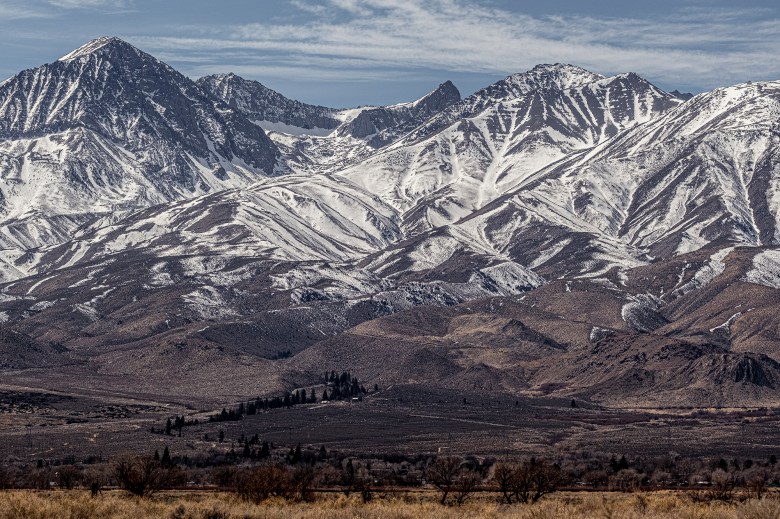
Flood control, power generation and maintaining water quality for people, ecosystems and threatened and endangered species all rely on the runoff forecasts. Even outdoor enthusiasts benefit from the snowmelt predictions. “We get a lot of calls saying, ‘Hey, you guys must know when the waterfalls in Yosemite are going to be going,’” Rizzardo said.
The problem? The forecasts haven’t yet factored in how climate change has altered snowmelt.
“Climate change,” Rizzardo said, “has thrown a monkey wrench at all this.”
Climate change upends calculations
As climate change drives temperatures ever hotter, the snowpack is retreating up mountain sides to higher altitudes and melting earlier in the season. And the wet season is contracting into a shorter, sharper period of storms.
The future, said state climatologist Michael Anderson, will continue to bring more rain and less snow and shift the surviving snowpack from the north’s lower peaks to the central and southern Sierra’s higher elevations. The shift will mean having to change water infrastructure to manage snowmelt storage and increased flood risks from rain mixing with snow.
“If you think of Lake Tahoe, we’ll get to a future where at lake level there won’t be any snow but in perhaps the mountains, there still will be snow,” Anderson said. “And then we watch it start to move upslope.”
Scientists predict that in the next 35 to 60 years, if carbon dioxide and other greenhouse gases continue unchecked, the West’s snowpack could shrink even more substantially and even disappear for a decade or more at a time.
“We’ll get to a future where at lake level there won’t be any snow but in perhaps the mountains, there still will be snow. And then we watch it move upslope.”
Michael Anderson, state climatologist
California already has seen a preview of this future, said Andrew Jones, a research scientist at Lawrence Berkeley National Laboratory and professor at the University of California, Berkeley.
In April 2015, former Gov. Jerry Brown watched as state staff measured a snowpack that didn’t exist — right when it should have been at its peak. It was the height of the last drought, which stretched from 2012 through 2016, and Brown stood in a field patched with dry grass. Behind him rose the bare slopes of what should have been snow-capped peaks.

“To know that this change is happening, and yet we’re all just living our lives and turning on the tap and using water as we always have done…it gives me a sense of appreciation for the fragility of the system that we have,” Jones said.
Though drought grips California once again, the snowpack wasn’t as scarce last year as it was in 2015. It was calculated at about 59 percent of normal in April 2021. But it took only one month for that snowpack to dwindle to 22 percent of normal in May. And, worse still, the rapidly melting snow didn’t refill rivers and reservoirs as expected.
Instead, it soaked into thirsty soils or disappeared into the air. By May, the runoff forecast for the Sacramento Valley had dropped by about 700,000 acre feet — enough water to supply 2.1 million Southern California households. All told, the forecasts overestimated runoff by 68 percent for the Sacramento River region and by 45 percent or more for major watersheds farther south, according to a state report.
“That was basically something we had never seen before. We have these various relationships that tell us if we have this much snow, you can expect this much water,” de Guzman said. “And that basically fell apart in 2021.”
Gleick said the overestimate had massive ramifications for the environment and the year ahead. For instance, when there was less water than projected, operators of the state and federal water projects petitioned regulators to relax requirements aimed at preventing saltwater from tainting key Delta water supplies in order to preserve more water in storage.
The shortfall was no surprise to Gleick, whose own research in the 1980s warned that climate change would shrink the snowpack.
“I would have suggested fixing the algorithms by the year 1990. But that didn’t happen,” he said. “So the best time to do it is right now.”
Turning up the forecasts
Revamping runoff forecasts will require collecting better data about the dwindling snowpack and creating more comprehensive models that better capture the changing conditions.
“It’s an understandable concern, (but) it isn’t easy science,” Rizzardo said.
“What last year did was say, ‘Okay, we just need to kick all this into high gear, and figure out a way to get it done.’”

Better data is already in the works. Ten years ago, the Department of Water Resources teamed up with NASA’s Jet Propulsion Laboratory to conduct detailed surveys of snow cover from airplanes equipped with a remote sensing device called lidar and other instruments.
So far, the surveys have been limited to five of the state’s watersheds. Though the partnership with NASA has ended, the list will almost double this year with the addition of the Feather, Yuba, Truckee and Carson rivers.
These measurements will be critical for feeding new, data-hungry models informed by climate factors and incorporating more information about the watersheds themselves, such as vegetation, temperature and soil moisture.
New technology, including sensors that quickly assess the snowpack’s temperature and how much water it contains, are now being test-driven by the University of California, Berkeley’s Central Sierra Snow Lab and state officials.
The question is whether the scientists will have to start from scratch and build a new model “or are there ways that we can tweak the existing models to really make them more accurate again?” said Andrew Schwartz, the snow lab’s lead scientist and station manager.
“The old models that have been developed for this runoff no longer really apply to today’s climate, because the climate has changed already,” he said.
“We have these various relationships that tell us if we have this much snow, you can expect this much water. And that basically fell apart in 2021.”
Sean de Guzman, Department of Water Resources
As part of a pilot project this year, one possible new model will include data from the airborne snow surveys of the Feather River and San Joaquin watersheds, and spit out forecasts that the scientists will compare to their current approach.
They already tried using machine-learning techniques to weigh factors like atmospheric dryness, soil moisture and temperature, but the multi-year effort yielded only slight improvements, de Guzman said.
This year, the team is working on what he calls a major tuneup, incorporating more recent rain, snow and runoff data that better captures the relationships under climate change.
“By changing a lot of the datasets that we’re feeding into the models, that will hopefully help give us a better picture of what we’re now seeing,” he said.
Despite the challenge of forecasting the future, some state officials don’t expect as significant a gap between expectation and reality this year. Although dry conditions persist now, storms late last year built up the snowpack and soaked the earth, priming conditions for more snowmelt to reach reservoirs.
Rizzardo, though, is less optimistic, particularly after the Berkeley snow lab reported a record-setting dry streak. “This is also part of the question mark, because we’re seeing things we’ve never seen before. And so we can’t say with certainty, ‘This is what it’s going to be.’”
Tuesday, February 22, 2022
Hard Freeze Warning: Temps Likely to Dip into the 20s
Posted By Kimberly Wear on Tue, Feb 22, 2022 at 2:47 PM
The Eureka office of the National Weather Service has issued a hard freeze warning from 1 a.m. to 9 a.m. Wednesday.
“Temperatures are forecast to dip into the upper 20s at most locations early Wednesday morning. Cold early morning temperatures are likely again on Thursday and Friday,” a NWS post states. “Record low temperatures are expected. Records at Crescent City are 30F Wednesday through Friday. At Eureka, record lows are 31F Wednesday through Friday.”
Residents in the region are being reminded to bring their pets and sensitive plants inside and to protect outdoor water pipes, which can freeze and burst.
Wednesday, February 16, 2022
No End in Sight: California Drought on Course to Break Another Record
Posted By Rachel Becker/CalMatters on Wed, Feb 16, 2022 at 11:25 AM
“There’s no precipitation forecast through the remainder of February. And there’s very little precipitation in the long-range forecast for March,” Erik Ekdahl, a deputy director with the State Water Resources Control Board, said at a board meeting Tuesday. “All this is pointing to, again, some pretty dire conditions statewide for drought.”
After record-setting storms in October and then December, the past six weeks — usually among the wettest months in California — have seen precipitation totals plateau at roughly half the yearly average in the state’s major watersheds.
The dry spell follows the driest year in California since 1924, as aridity continues to dominate the West. Currently, the U.S. Drought Monitor currently shows most of Humboldt County in moderate drought conditions, with the south-eastern portion in severe drought.

LESSONS LEARNED: DROUGHT THEN AND NOW
A CalMatters series investigates what’s improved and what’s worsened since the last drought — and vividly portrays the impacts on California’s places and people.
The prolonged drought, which began in early 2020, leaves many water suppliers leaning more on their stored water supplies or shifting to other sources, such as groundwater.
Jennifer Pierre, general manager of the State Water Contractors, an association of water agencies in Southern and Northern California and the San Joaquin Valley that receive supplies from the State Water Project, called the storms late last year “a blip” that meant little to California’s water supplies.
The agencies are getting 15 percent of their requested supplies from the state aqueduct, which carries water from Northern California rivers south. Initially, the allocations were set at zero, which meant deliveries would only cover enough for public health and safety.
For residents of the Silicon Valley, the conditions could mean tightening restrictions and increasing rebates to reduce water use. In San Jose, customers who exceed limits — based on a 15 percent cut in amounts of water they used in 2019 — already have to pay extra fees.
The drought has collided with earthquake retrofits that required almost completely draining the area’s largest reservoir, knocking out more than half of the storage capacity serving 2 million people in and around San Jose.
In June, Valley Water’s board mandated a 15 percent cut to water use from 2019 levels, to be implemented by the local water agencies it supplies. Board chair Gary Kremen said he wouldn’t be surprised to see an update to the restrictions and rebate programs come up for another vote.
“You use the word dire,” Kremen said. “But for us, it’s kind of worse than dire.”
Odds are increasing that February, the wettest month of the year in California, will be nearly or completely dry across much of the state.
California is already in the midst of a severe multi-year drought, with fire danger skyrocketing across much of the state. #CAwx #CAfire pic.twitter.com/RkZmdKcZRB
— US StormWatch (@US_Stormwatch) February 12, 2022
The storms early in the rainy season mean California’s water supplies are in better shape now than last year, said state climatologist Michael Anderson. Nearly the entire state is in moderate drought, with about two-thirds in severe drought. But if precipitation totals hold, he expects this year to round out the driest three years on record — even drier than the three-year span between 2013 and 2015 during the last record-breaking drought.
“The challenge is, this is year three of the drought rather than year two,” Anderson said. “And in terms of a three-year period, we’re likely going to set a new record for a three-year window of drought.”
The snowpack, too, hasn’t increased. A critical water supply, the Sierra Nevada snowpack was measured at 72 percent of normal for Feb. 15, but only 55 percent of the seasonal average measured on April 1. And in parts of the state, the snow is already melting.
“You’re in this window where you’re still expecting to be building (snow)pack, but it’s already starting to melt,” Anderson said. “The challenge will be how much snowpack makes it to spring, and how much shows up in the reservoirs.”
Anderson is keeping an eye on the months ahead, and hopes that March will bring more rain and snow than anticipated. A big question will be how much runoff from snow melt in the Sierra Nevada will reach California’s reservoirs, which saw substantially less runoff than expected last year.
“The good news is there’s room in the reservoirs to capture what does make it to the streams and come down,” he said. “The challenge is that if we’re dry this early, the demands for water start earlier.”
Most of the state’s reservoirs are sitting below historic averages despite the December deluge, with some notable exceptions, such as Folsom Reservoir — “the breadwinner of the storms,” Michael Macon, who works with the water board’s Division of Water Rights, said Tuesday.
Lake Shasta is about half a million acre-feet — enough to supply 1.5 million households for one year — short of where it stood last year. Oroville has climbed above last year’s levels, but the amount of water flowing out is starting to match water flowing in following a dry January, Macon said.
Looking ahead, Anderson says it’s a matter of waiting and watching whether spring brings more rain and snow, and how quickly summer heats up.
“The challenge then becomes, well, what does summer look like? Does it heat up really fast? Do we end up with a lot of heat waves?” he said. “Or do we get a little bit of a break with some cooler weather?”
Tuesday, February 15, 2022
Ag Producers Urged to Apply Now for Emergency Access Passes
Posted By Kimberly Wear on Tue, Feb 15, 2022 at 12:21 PM
With the need to prepare for wildfires before winter even draws to a close becoming more critical as megablazes move into year-round threats — with each new fire season surpassing the last — Humboldt agricultural producers are being encouraged to apply now for a Restricted Area Access Pass.
Having the annually issued pass is a step in allowing “qualifying agricultural and cannabis producers/cultivators and/or commercial livestock operators” to get past road closures to take care of their crops and animals in the event of evacuations due to wildfire or other emergencies, according to the Humboldt County Sheriff’s Office.
A new study published this week in the journal Nature Climate Change found the severity of drought conditions plaguing California and the West for the last two decades is the worst in 1,200 years, dating back to at least 800 A.D., when Charlemange was crowned Holy Roman Emperor of the West. The conditions, the study notes, “will very likely persist through 2022,” with humans-caused climate change playing a major role.
Currently, the U.S. Drought Monitor currently shows most of Humboldt County in moderate drought conditions, with the south-eastern portion in severe drought.
“In recent years, Humboldt County has felt the impact of wildfires, some of which required evacuations within our most rural communities,” Humboldt County Sheriff William Honsal said in a recent news release. “We realize the impact even a few days away from home can have on an agriculture business. In this last year, the Restricted Area Access Pass Program allowed ag business owners access past closed roadways to take care of business safely while firefighters worked to mitigate the Knob Fire.”
The wildfire near Willow Creek led to several days of evacuations and evacuation warnings in late August and early September. A year earlier, Humboldt County residents awoke Sept. 9, 2020, to the apocalyptic glow of an eerie orange sky created by heavy haze in the air from surrounding wildfires, including the Hopkins Fire, which prompted evacuations south of State Route 36 in Bridgeville and all communities along Alderpoint Road down to the Mendocino/ Trinity County Line.
A few weeks later, swaths of Southern Humboldt were placed under evacuation warnings due to the August Complex.
This year's applications for the Restricted Area Access Pass with the Humboldt County Office of Emergency Services are due by Aug. 1 and will run through Dec. 22.
“The access pass is not a guaranteed permit to enter a restricted zone but is a necessary pre-registration step making it easier for agricultural producers to access their livestock or crops during an emergency,” OES Manager Ryan Derby said in the release. “Please make every effort to apply for this program prior to an emergency occurring.”
Read more from the HCSO about how the pass program works and how to apply below:
The passes will be administered and approved through OES, in partnership with the county Agricultural Commissioner’s Office and the Planning & Building Department.
Once issued an access pass, agricultural producers with operations located within an evacuation zone must notify OES or the Agricultural Commissioner’s Office of their interest in accessing the property.
Authorization to enter restricted zones will be given daily and decided based upon the conditions. The pass holder will be notified of approval.
Following notification, pass holders can access their property through a law enforcement checkpoint during daylight hours. The Restricted Area Access Pass does not grant authority to the pass holder to stay at their residence and/or business when an evacuation order is issued.
The access passes will be valid through December 31, 2022.
Humboldt County residents can learn more about the Restricted Area Access Pass Program and apply at humboldtsheriff.org/oes.
All Humboldt County residents are encouraged to prepare now for an emergency by assembling an emergency supply kit and creating a family communication plan.
Residents should also be sure to “Know Your Zone,” by checking your designated evacuation zone at community.zonehaven.com. Should an evacuation occur in your community, OES will use your evacuation zone name when announcing evacuation orders.
To ensure you receive the most up-to-date information and emergency alerts, sign up for Humboldt ALERT, Humboldt County’s emergency alert system.

